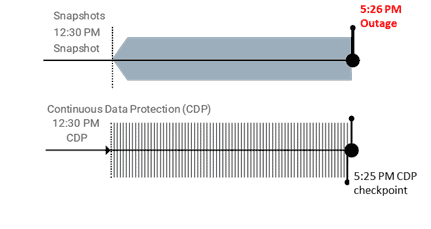Continuous Data Protection (CDP)
A-to-Zerto Glossary of Terms
Overview
Continuous data protection (CDP) provides granular recovery to within seconds of data that can go back seconds or years as needed. The option to recover to many more granular points in time minimizes data loss to seconds, dramatically reducing the impact of outages and disruptions to your organization.
Related Topics
What Is Continuous Data Protection or CDP?
Continuous data protection is a protection mechanism that allows organizations to continuously capture and track data changes, automatically saving every version of the data that the user creates locally or at a target repository.
With CDP, writes are saved to a journal file along with the corresponding file changes. CDP allows users or administrators the ability to restore data to any point in time with remarkable granularity.
5 Important Questions to Ask About Continuous Data Protection
Why Choose Continous Data Protection?
Continuous data protection utilizes journal-based technology to keep a log of all the changes occurring in a specified time frame, offering any point-in-time recovery in increments of seconds for the entire length of the journal.
Unlike legacy systems, which accumulate data periodically throughout the day and then attempt to complete a backup during a time window, CDP constantly backs up your data. For example, snapshot-based recovery puts your business at risk of higher data loss due to infrequent restore points that are captured, while CDP minimizes this with thousands of restore points throughout the journal history, as shown in the figure below.

CDP offers the insurance of minimal operational impact in the event of an outage —whether natural or man-made— and is therefore a great solution for disaster recovery and ransomware recovery use cases requiring the lowest downtime and data loss.
Go from Snapshots to Streaming with Continuous Data Protection
Comparing Continuous Data Protection to Snapshot-based Technologies
Zerto Continuous Data Protection
Zerto CDP offers effective data protection for business applications and data, including:
- Real-time block-level replication. Zerto CDP utilizes change-block tracking to constantly replicate data as it is written to storage.
- No performance impact. With Zerto CDP, the journal is only used until the point in time is selected, without the performance impact of many snapshots.
- Journal-based, any point-in-time recovery. Journal-based recovery keeps a constant log of all the changes users make to applications and data.
- Enterprise scalability. Place the journal on any datastore with maximum size limits and warnings, preventing the datastore from filling, which would otherwise break replication.
- Storage savings. Zerto CDP uses no extra space in the source storage as no snapshots are created. Only 7-10 percent of the target storage is used, which frees up significant amounts of space and results in dramatic savings.
- Ransomware recovery down to the second. In the event of ransomware or other malicious attacks, recover data to just seconds before the corruption took place, minimizing the impact to business.
What's Make Zerto Unique? Unlike other continous data protection vendors, Zerto has created its own technology to deliver CDP, with its proprietary I/O Filter zDriver. As a result, it can do more, like support and deliver services with various types of hypervisors for instance. Zerto really delivers true continuous data protection.
Zerto Continuous Data Protection
Zerto Continuous Data Protection vs Competition
Frequently Asked Questions about Continuous Data Protection
Continuous data protection, or CDP, is a protection mechanism that allows organizations to continuously capture and track block-level changes. CDP can enable users to restore data and applications to any point in time with ultra-high levels of granularity.
VMware introduced vSphere APIs for I/O Filtering (VAIO) in vSphere 6 Update 1. VAIO I/O filters enable any vendor to use their API to intercept and manipulate the I/O in order to build their own version of “CDP” limited to VMware environments specifically.
Zerto’s CDP technology is made possible with its patented, proprietary I/O filter that has been battle-tested at scale—thousands of VMs with single-digit RPOs—and is able to support and deliver services with various types of hypervisors and virtualized environments.
CDP Products Comparison
Since usually CDP uses block-level replication, newly created or modified storage block data get saved in real-time, or near real-time. In effect, this eliminates the “backup window” required by traditional backup solutions and reduces the potential data loss between subsequent backups, which usually occur at night time and/or over weekends because of the impact on the production environment. As a result, CDP delivers significantly lower RPOs than backup solutions.
Zerto is a solution based on continuous data protection. Zerto has created its own technology to deliver CDP, with its proprietary I/O Filter zDriver. As a result, it can do more, like support and deliver services with various types of hypervisors, for instance, or protect and recover an entire multi-VM app stack, even if the VMs sit on different hosts and data stores.
Other Resources
LATEST FROM ZERTO SEE ALL
Resource Center
Discover and access content from Zerto and 3rd parties (IDC, Gartner, ESG, etc.) related to continuous data protection (CDP).
Continuous Data Protection in Zerto Cyber Resilience Vault
Learn about how Zerto's CDP is used in the Zerto Cyber Resilience Vault.
Zerto Continuous Data Protection: Learn What True CDP Really Is
Learn what components make a true CDP solution that delivers the best RTOs and RPOs in the industry.
What is Zerto?
Learn about Zerto and how it can help you solve your data protection and recovery challenges.